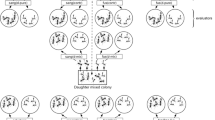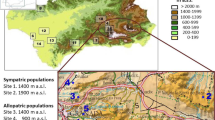Abstract
Slave-making ants exploit the labour of their own or another species. Temnothorax ambiguus and T. longispinosus are both ant species that serve as hosts of the obligatory slave-making ant Protomognathus americanus and are facultative slave-makers themselves. We offered laboratory colonies of T. ambiguus and T. longispinosus a series of choices among different larval types to better understand their brood discrimination abilities. Workers of both species preferentially accepted nestmate over non-nestmate larvae. Both species preferentially retrieved unrelated conspecific larvae over congeneric allospecific larvae, and T. ambiguus workers consumed more allospecifics than conspecifics. When presented with conspecific versus P. americanus larvae, both species manifested a clear bias towards conspecific larvae in terms of earlier retrieval and reduced cannibalism. That workers did not prefer P. americanus larvae over conspecific larvae as documented in previous research likely reflects the fact that in the present study, subject workers had access to the entirety of their colony as a referent during rearing and at the time of testing, as they would in nature. Moreover, reciprocal contact between P. americanus and conspecific larvae increased acceptance of the slave-maker larvae, but did not appear to lessen the acceptability of conspecific larvae. This suggests that transfer of cues through contact may be sufficient to alter the recognition signature of P. americanus larvae increasing acceptability by their hosts.



Similar content being viewed by others
References
Alloway T.M. 1979. Raiding behaviour of two species of slave-making ants, Harpagoxenus americanus (Emery) and Leptothorax duloticus Wesson (Hymenoptera: Formicidae). Anim. Behav. 27: 202-210.
Alloway T.M. 1980. The origins of slavery in leptothoracine ants (Hymenoptera: Formicidae). Am. Nat. 115: 247-261.
Alloway T.M. 1982. How the slave-making ant Harpagoxenus americanus (Emery) affects the pupa-acceptance behavior of its slaves. In: The Biology of Social Insects (Breed M.D., Michener C.D. and Evans H.E., Eds), Westview Press, Boulder, Colorado, U.S.A., pp 261-265.
Alloway T.M. 1989. Slave-species ant colonies recognize slave-makers as enemies. Anim. Behav. 39: 1218-1220.
Alloway T.M. and Hare J.F. 1989. Experience-independent attraction to slave-maker ant larvae in host-species ant workers (Leptothorax longispinosus; Hymenoptera: Formicidae). Behaviour 110: 93-105.
Alloway T.M. and Keough G. 1990. Slave marking by the slave-making ant Harpagoxenus americanus (Emery) (Hymenoptera: Formicidae). Psyche 97: 55-64.
Alloway T.M., Buschinger A., Talbot M., Stuart R. and Thomas C. 1982. Polygyny and polydomy in three North American species of the ant genus Leptothorax Mayr (Hymenoptera: Formicidae). Psyche 89: 249-274.
Bhatkar A. and Whitcomb W.H. 1970. Artificial diet for rearing various species of ants. Fla. Entomol. 53: 229-232.
Brandt M., Heinze J., Schmitt T. and Foitzik S. 2005. A chemical level in the coevolutionary arms race between an ant social parasite and its hosts. J. Evol. Biol. 18: 576-586.
Brian M.V. 1975. Larval recognition by workers of the ant Myrmica. Anim. Behav. 23: 745-756.
Carlin N.F. 1988. Species, kin and other forms of recognition in the brood discrimination behavior of ants. In: Advances in Myrmecology (Trager J.C. and Brill E.J., Eds), Leiden, New York, U.S.A., pp 267-295.
Creighton W.S. 1927. The slave-raids of Harpagoxenus americanus. Psyche 34: 11-29.
Del Rio Pesado M.G. and Alloway T.M. 1983. Polydomy in the slave-making ant, Harpagoxenus americanus (Emery) (Hymenoptera: Formicidae). Psyche 90: 151-162.
Dettner K. and Liepert C. 1994. Chemical mimicry and camouflage. Annu. Rev. Entomol. 39: 129-154.
Gamboa G.J. 2004. Kin recognition in eusocial wasps. Ann. Zool. Fennici. 41: 789-808.
Hamilton W.D. 1964. The genetical evolution of social behaviour: I and II. J. Theor. Biol. 7: 1-52.
Hare J.F. 1996. Discrimination of nestmate larvae by the ant Leptothorax longispinosus. Can. J. Zool. 74: 2055-2061.
Hare J.F. and Alloway T.M. 1987. Early learning and brood discrimination in leptothoracine ants (Hymenoptera: Formicidae). Anim. Behav. 35: 1720-1724.
Herbers J.M. 1986. Nest site limitation and facultative polygyny in the ant Leptothorax longispinosus. Behav. Ecol. Sociobiol. 19: 115-122.
Herbers J.M. and Grieco S. 1994. Population structure of Leptothorax ambiguus, a facultatively polygynous and polydomous ant species. J. Evol. Biol. 7: 581-598.
Hölldobler B. and Wilson E.O. 1990. The Ants. Harvard University Press, Cambridge, Massachusetts, U.S.A.
Hölldobler B. and Wilson E.O. 2008. The Superorganism: the Beauty, Elegance, and Strangeness of Insect Societies. WW Norton & Company, New York, U.S.A.
Holmes W.G. and Sherman P.W. 1983. Kin recognition in animals. Amer. Sci. 71: 46-55.
Howard R.W. 1993. Cuticular hydrocarbons and chemical communication. In: Insect Lipids: Chemistry, Biochemistry and Biology (Stanley-Samuelson D.W. and Nelson D.R., Eds), University of Nebraska Press, Nebraska, U.S.A. pp 179-226.
Jaisson P. 1991. Kinship and fellowship in ants and social wasps. In: Kin Recognition (Hepper P.G., Ed), Cambridge University Press, Cambridge, England. pp 60-93.
Johnson C.A., Vander Meer R.K. and Lavine B. 2001. Changes in the cuticular hydrocarbon profile of the slave-maker ant queen, Polyergus breviceps Emery, after killing a Formica host queen (Hymenoptera: Formicidae). J. Chem. Ecol. 27: 1787-1804.
Johnson C.A., Topoff H., Vander Meer R.K. and Lavine B. 2005. Do these eggs smell funny to you?: an experimental study of egg discrimination by hosts of the social parasite Polyergus breviceps (Hymenoptera: Formicidae). Behav. Ecol. Sociobiol. 57: 245-255.
Lenoir A. 1981. Brood retrieving in the ant Lasius niger L. Sociobiology 6: 152-178.
Lenoir A. 1984. Brood-colony recognition in Cataglyphis cursor worker ants (Hymenoptera: Formicidae). Anim. Behav. 32: 942-944.
Lenoir A., D’Ettorre P. and Errard C. 2001. Chemical ecology and social parasitism in ants. Annu. Rev. Entomol. 46: 573-599.
Lorenzi M.C., Bagnères A.G. and Clément J.L. 1996. The role of cuticular hydrocarbons in social insects: is it the same in paper-wasps? In: Natural History and Evolution of Paper-Wasps (Turillazzi S. and West-Eberhard M.J., Eds), Oxford University Press, New York, U.S.A. pp 178-189.
Panek L.M. and Gamboa G.J. 2000. Queens of the paper wasp Polistes fuscatus (Hymenoptera: Vespidae) discriminate among larvae on the basis of relatedness. Ethology 106: 159-170.
Reeve H.K. 1989. The evolution of conspecific acceptance thresholds. Amer. Nat. 133: 407-435.
Stuart R.J. 1985. Spontaneous polydomy in laboratory colonies of the ant Leptothorax curvispinosus Mayr (Hymenoptera: Formicidae). Psyche 92: 71-81.
Stuart R.J. and Alloway T.M. 1982. Territoriality and the origin of slave raiding in leptothoracine ants. Science 215: 1262-1263.
Stuart R.J. and Herbers J.M. 2000. Nest mate recognition in ants with complex colonies: within- and between-population variation. Behav. Ecol. 6: 676-685.
Sturtevant A.H. 1927. The social parasitism of the ant Harpagoxenus americanus. Psyche 34: 1-9.
Wilson E.O. 1971. The Insect Societies. The Belknap Press of Harvard University Press, Cambridge, Massachusetts, U.S.A.
Wilson E.O. 1975. Sociobiology. Harvard University Press, Cambridge, Massachusetts, U.S.A.
Acknowledgments
This research was supported by a Natural Sciences and Engineering Research Council of Canada (NSERC) Postgraduate Scholarship and a Manitoba Graduate Scholarship awarded to D.C.S. and a NSERC Discovery Grant awarded to J.F.H. We are grateful to T.M. Alloway and J. Beckwith for helping with the collection of ants and for providing valuable insight into the habits of our study organisms. W. Freeman also assisted during ant collection and S. Whyard provided initial cultures of Drosophila melanogaster. Thanks to S. Sealy, R. Currie and A. Roche for constructive feedback on the thesis from which this manuscript was derived and to four anonymous reviewers for comments on previous versions of this manuscript. C. Swan provided valuable assistance with the construction of artificial nests. Special thanks to M. Bromilow for her love and care of D.C.S. and the ants used in this study.
Author information
Authors and Affiliations
Corresponding author
Rights and permissions
About this article
Cite this article
Swan, D.C., Hare, J.F. Larval recognition by Temnothorax longispinosus and T. ambiguus hosts of the slave-making ant Protomognathus americanus revisited: colony-level referent ensures conspecific preference. Insect. Soc. 59, 511–517 (2012). https://doi.org/10.1007/s00040-012-0245-7
Received:
Revised:
Accepted:
Published:
Issue Date:
DOI: https://doi.org/10.1007/s00040-012-0245-7




